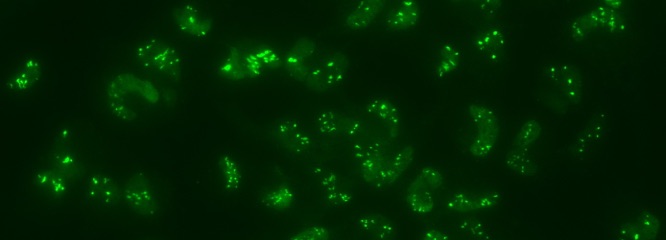Interaction of radiation with matter
Many areas of applications of laser-driven radiation sources are based on the interaction of ionizing radiation with matter, e.g. in material science or in a biomedical context.
CPP researchers are particularly active in exploring the response of matter to irradiation by intense beams of laser-driven ions. A particularly interesting aspect of these interactions arises from the peculiar properties of laser-driven ion sources, which can deliver large doses to a sample in very short times (ranging from 10s of ps to ns depending on the sample distance from the source), resulting in extremely high dose rates (in excess of 109 Gy/s).
We have an active programme of research exploring the radiobiology of these extreme irradiation regimes, which we carry out in close collaboration with The Patrick G Johnston Centre for Cancer Research. In experiments at the QUB TARANIS facility as well as at the Rutherford Appleton Laboratory, we irradiate cellular samples (including both normal and cancerous cells) with laser-accelerated, short burst of protons and Carbon ions, and we investigate the biological effects of these processes (e.g. damage to the cells’ DNA and subsequent cell death, or inhibition of cell functions in surviving cells). This research is aimed to establish the biological effectiveness of irradiations at these extreme, and yet unexplored, dose rates, in comparison with known cell response at the standard dose rates employed in radiobiology and cancer radiotherapy. A programme of irradiations at conventional accelerators supports these investigations, which are aimed to establish a basis for the potential future use of laser-driven particle in radiotherapy.
Additionally, we employ laser-driven ion bursts, to investigate the ultrafast material response of irradiated samples, which include solid state materials, as well as water. This research employs a pump-probe arrangement pioneered at QUB, which allows investigating the response of transparent material to pulsed ion of ions, with picosecond resolution. Application of this technique to glass and silica samples has allowed the measurement of the material-dependent recovery time by observing the transient opacity of the samples. The investigation of the ultrafast radiochemistry of water is of clear relevance to the context of cancer hadrontherapy.
SOME RECENT PUBLICATIONS:
- P. Chaudhary, G. Milluzzo, A. McIlvenny, H. Ahmed, A.McMurray, C. Maiorino, K. Polin, L. Romagnani, D. Doria, S. J. McMahon, S. W. Botchway, P.P. Rajeev, K. M. Prise, M. Borghesi, Cellular irradiations with laser-driven carbon ions at ultra-high dose rates, Phys. Med. Biol., 68, 025015 (2023)
- C.A. McAnespie, M.J.V Streeter, M. Rankin, P. Chaudhary, S. McMahon, K.M. Prise, G. Sarri, High-dose femtosecond-scale gamma-ray beams for radiobiological applications, Phys. Med. Biol., 67, 085010 (2022)
- A. Prasselsperger, M. Coughlan, N. Breslin, M. Yeung, C. Arthur, H. Donnelly, S. White, M. Afshari, M. Speicher, R. Yang, B. Villagomez-Bernabe, F.J. Currell, J. Schreiber, B. Dromey, Real-Time Electron Solvation Induced by Bursts of Laser-Accelerated Protons in Liquid Water, Phys. Rev. Lett., 127, 186001 (2021)
- P. Chaudhary, G. Milluzzo, H. Ahmed, B. Odlozilik, A. McMurray, K. Prise, M. Borghesi, Radiobiology Experiments With Ultra-high Dose Rate Laser-Driven Protons: Methodology and State-of-the-Art, Front. Phys., 9, 624963 (2021)
- M.Coughlan, H. Donnelly, N. Breslin, C. Arthur, G. Nersyisian, M. Yeung, B. Villagomez-Bernabe, M. Afshari, F. Currell, M.Zepf, B. Dromey, Ultrafast dynamics and evolution of ion-induced opacity in transparent dielectrics, New J. Phys, 22, 103023 (2020)
CURRENT FUNDING:
- Ultrafast Nanodosimetry - the role of the nanoscale in radiation interactions in matter, EPSRC (2022-26)
- IMPULSE (Integrated Management and Reliable Operations for User-based Laser Scientific Excellence), EU H2020 871161 (2020-24)
- Modelling energy transfer during irradiation of matter by swift particles , Leverhulme Trust (2020-24)
